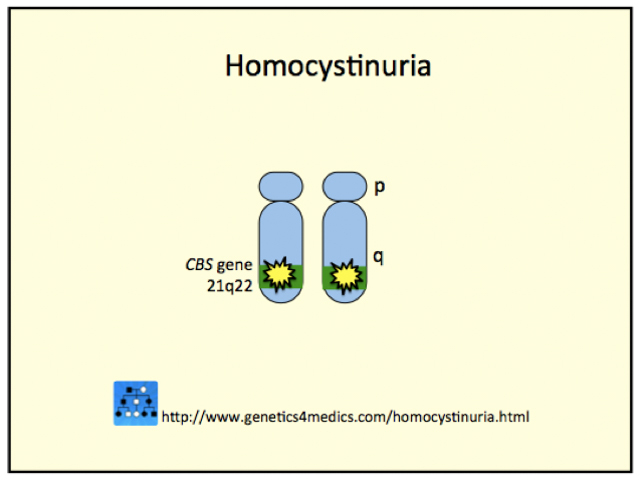Main menu
Common skin conditions

NEWS
Join DermNet PRO
Read more
Quick links
Homocystinuria — extra information
Homocystinuria
Author: Brian Wu PhD. MD Candidate, Keck School of Medicine, Los Angeles, USA; Chief Editor: Dr Amanda Oakley, Dermatologist, Hamilton, New Zealand, September 2015.
What is homocystinuria?
Homocystinuria is a genetic, inherited disorder characterised by elevated urine and serum concentrations of homocysteine (an amino acid). People with homocystinuria cannot properly process the amino acid metathionine, which is needed for growth and development in children and to maintain nitrogen balance in adults.
What are the signs and symptoms of homocystinuria?
Newborns with homocystinuria often appear normal, but signs and symptoms begin to develop in the first year of life, though they are not all obvious at first.
Signs and symptoms of homocystinuria may vary widely, and patients can present with any of the following:
- Marfanoid appearance (this refers to the tall, thin build and long-limbed appearance reminiscent of Marfan syndrome)
- Pectus carinatum or pectus excavatum (the depression of protrusion of the sternum)
- High, arched palate with crowding of the teeth
- Kyphoscoliosis
- Ectopic lentis (dislocation of the lens)
- Myopia
- Glaucoma
- Intellectual disability (with an average IQ of 80, although approximately 30% of patients with homocystinuria have IQs in the normal range).
- Arachnodactyly (long, spidery fingers)
- Seizures
- Cerebrovascular events
- Psychiatric disorders
- Osteoporosis
- Infant failure to thrive
- Increased chance of blood clot formation and for deep vein thrombosis
Cutaneous signs of homocystinuria include:
- Hypopigmentation due to inhibition of tyrosinase
- Fair and thin hair
- Thin, translucent skin
- Hyperhidrosis
- Dry skin with tendency to eczema
- Vitiligo
- Flushed cheeks with large pores
- Livedo reticularis
- Atrophic scars on arms and hands
- Telangiectasia
What causes homocystinuria?
Homocystinuria is inherited in an autosomal recessive pattern. Mutations of the CBS, MTHFR, MTR, MTRR and MMASHC genes have been implicated.
These mutations can lead to:
- deficiency of cystathionine beta synthase (CBS)
- deficiency of 5,10-methlemetetrahydrofolate reductase
- deficiency of cobalamin in coenzyme synthesis
- enzyme abnormalities affecting the conversion of homocysteine to metathionine

Genetics of Homocystinuria*
*Image courtesy Genetics 4 Medics
How is homocystinuria diagnosed?
Testing for homocystinuria can include:
- Cyanide-nitroprusside test
- Serum and urine amino acid screening
- Plasma levels of free methionine
- Ophthalmological exam for myopia, ectopic lentis
- Skin biopsy with fibroblast culture
- Skeletal X-ray
- Liver biopsy with enzyme assay
- MTHFR genotyping
How is homocystinuria treated?
There remains no cure for homocystinuria. However, around half of patients respond to high doses of pyridoxine (B6). Skin pigmentation can return to normal.
For those not responsive to pyridoxine, other treatments include:
- A low metathionine diet (this includes carrots, beets, chard, tomatoes, spinach, peppers, melons, apples, pears but excludes broccoli, mushrooms, avocados, potatoes, nuts, tofu and black or kidney beans, due to amino acid content)
- Trimethylglycine (betaine)
- Folic acid supplementation and adding cysteine to the diet
Many patients with homocystinuria die as young adults due to arterial and venous thrombosis.
References
- Diet. Homocystinuria Support. 2013.
- Homocystinuria. Genetics Home Reference. National Institutes of Health.
- Homocystinuria. Medline Plus. 2015.
- Homocystinuria. WebMD. 2014.
On DermNet
Other websites
- Dermatologic Manifestations of Homocystinuria
- Homocystinuria/Homocysteinemia — Medscape Reference
